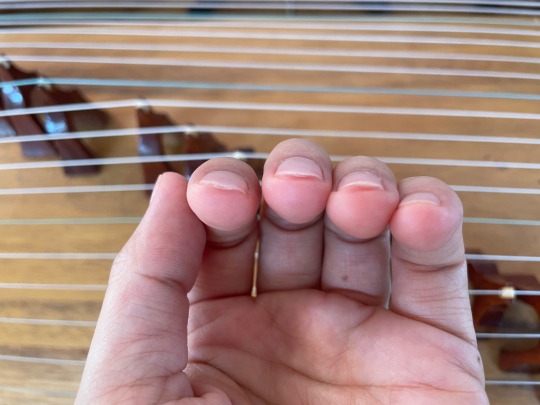Photo

Right fingers techniques:
1. xiao cuo (小撮) — using the thumb and the index finger to pluck two strings that have one, two, or three strings between them. Fingers are moving toward the palm in a closing motion.
2. da cuo (大撮) — using the thumb and the middle finger to pluck two strings that have four strings between them. Fingers are moving toward the palm in a closing motion.
3. arpeggios or pa yin (琶音). Using three or four fingers to pluck strings from a low to high sequence to create the notes of a chord.
0 notes
Photo

My fourth practice piece: Canon. This is by far the hardest piece for me. I completed it but still have not gotten it to the level of mastery.
0 notes
Photo

Due to the constant fluctuation of weather and humidity in Taiwan, my guzheng is always out of tune. Tuning the guzheng before practice has become a new ritual for me. Each string’s pitch is checked by using my left hand to pluck the string’s right side. For D major, the notes are D, E, F#, A, and B. And, a chromatic tuner, calibrated to 442Hz, is used to check whether or not to use a tuning wrench to tighten or loosen the strings.
0 notes
Photo

My third practice piece: Zuo Shou Zhi Yue (左手指月). Playing with both hands is difficult. I’ve been practicing new left-hand techniques as well. After weeks of struggles and clumsiness, I finally managed to play this.
0 notes
Photo

The guzheng uses pentatonic tuning in names of Gong (宮), Shang (商), Jue (角), Zhi (徵), Yu (羽.), and they correspond to do, re, mi, sol, la. The missing tune of fa and si can be created by using the left hand to press down on the strings of mi and la to change the tune.
0 notes
Photo

I’ve learned and practiced by pressing down on a string with my left hand, using the index, middle, and ring fingertips. Pressing on the same string immediately after or before the right hand plucks a string, can change the scale or melody. Also, while pressing the strings, differing the pressure applied creates various sound effects. My left fingers develop a burning sensation…
0 notes
Photo

My brain and fingers still don't coordinate well, but the music is sounding better than last week. I need to develop muscle memory with practice and continue to be patient and compassionate with myself. It takes discipline and time, which certainly can't be rushed.
2 notes
·
View notes
Photo


Moving on to my second practice piece, I am trying to get a sense of what to do with my hands. I was able to manage the first song because I only needed to focus on plucking five strings mostly and those strings were adjacent to each other. But, for the second song, the tune required skipping strings which forced me to count strings since I have not committed the placement of strings to memory, yet.
I am experiencing difficulty reading the music translating the numbers to corresponding strings. In addition, my left hand is supposed to move along the string that my right hand plucks, but I’m struggling. Sounds simple, but for me, it’s not. For now, I focus on my right hand...
1 note
·
View note
Photo

My first practice piece: Xiao Ao Jiang Hu (笑傲江湖)
1 note
·
View note
Photo

The basics of plucking the strings of the guzheng use the right hand.
The name of the thumb plucking is tuo (托).
The name of the index finger plucking is mo (抹).
The name of the middle finger plucking is gou (勾).
0 notes
Photo



I have purchased and began my guzheng online course since August, 16th. In my first two weeks of lessons, I have learned the basics about guzheng, including the structure of the guzheng, how to put artificial nails on, how to keep a good “c” hand-shape, and how to read the notes and rhythm.
2 notes
·
View notes
